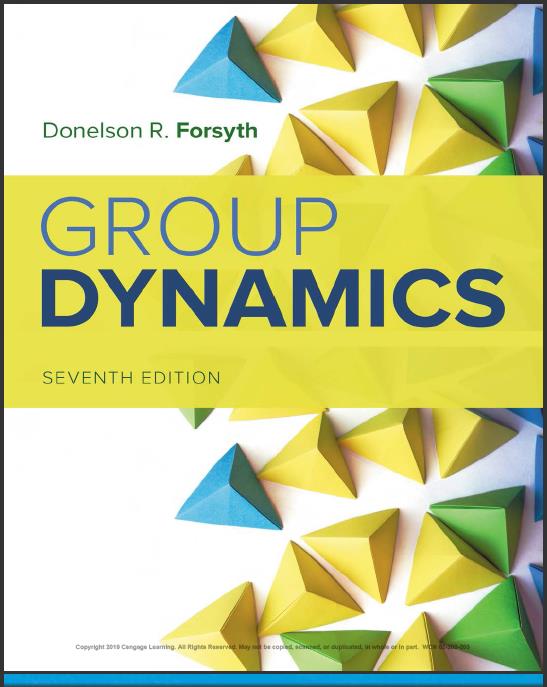Solution manual for Group Dynamics 7th Edition by Donelson Forsyth 1337408859 9781337408851
$70.00 Original price was: $70.00.$35.00Current price is: $35.00.
Instant download (Solution manual) Group Dynamics 7th Edition by Donelson R. Forsyth after payment
Solution manual for Group Dynamics 7th Edition by Donelson Forsyth – Ebook PDF Instant Download/Delivery: 1337408859, 9781337408851
Full download Group Dynamics 7th Edition after payment

Product details:
ISBN 10: 1337408859
ISBN 13: 9781337408851
Author: Donelson R. Forsyth
Learn how group dynamics theory applies in the real world with the help of this best seller. GROUP DYNAMICS, 7th Edition, covers all major theories and topics pertaining to group and team processes. Focus on what’s most important with clearly organized chapters and highlighted key points, and see how to apply concepts to actual groups through extended case studies — one in every chapter. The author draws on examples from a range of disciplines including psychology, management, law, education, sociology, and political science to help you develop a deeper understanding of each topic that you’ll take with you beyond the classroom.
Group Dynamics 7th Table of contents:
Chapter 1. Introduction to Group Dynamics
1-1. What Are Groups?
1-1a. Defining Groups
1-1b. Varieties of Groups
1-1c. Characteristics of Groups
1-2. What Are Group Dynamics?
1-2a. Dynamic Group Processes
1-2b. Process and Progress over Time
1-3. Why Study Groups?
1-3a. Understanding People
1-3b. Understanding the Social World
1-3c. Applications to Practical Problems
1-4. The Value of Groups
Chapter Review
Resources
Chapter 2. Studying Groups
2-1. The Scientific Study of Groups
2-1a. The Individual and the Group
2-1b. The Multilevel Perspective
2-2. Measurement
2-2a. Observation
2-2b. Self-Report
2-3. Research Methods in Group Dynamics
2-3a. Case Studies
2-3b. Correlational Studies
2-3c. Experimental Studies
2-3d. Studying Groups: Issues and Implications
2-4. Theoretical Perspectives
2-4a. Motivational Perspectives
2-4b. Behavioral Perspectives
2-4c. Systems Perspectives
2-4d. Cognitive Perspectives
2-4e. Biological Perspectives
2-4f. Selecting a Theoretical Perspective
Chapter Review
Resources
Chapter 3. Inclusion and Identity
3-1. From Isolation to Inclusion
3-1a. The Need to Belong
3-1b. Inclusion and Exclusion
3-1c. Inclusion and Human Nature
3-2. From Individualism to Collectivism
3-2a. Creating Cooperation
3-2b. The Social Self
3-3. From Personal Identity to Social Identity
3-3a. Social Identity Theory: The Basics
3-3b. Motivation and Social Identity
Chapter Review
Resources
Chapter 4. Formation
4-1. Joining Groups
4-1a. Personality Traits
4-1b. Anxiety and Attachment
4-1c. Social Motivation
4-1d. Men, Women, and Groups
4-1e. Attitudes, Experiences, and Expectations
4-2. Affiliation
4-2a. Social Comparison
4-2b. Stress and Affiliation
4-2c. Social Comparison and the Self
4-3. Attraction
4-3a. Principles of Attraction
4-3b. The Economics of Membership
Chapter Review
Resources
Chapter 5. Cohesion and Development
5-1. Sources of Cohesion
5-1a. Social Cohesion
5-1b. Task Cohesion
5-1c. Collective Cohesion
5-1d. Emotional Cohesion
5-1e. Structural Cohesion
5-1f. Assumptions and Assessments
5-2. Developing Cohesion
5-2a. Theories of Group Development
5-2b. Five Stages of Development
5-2c. Cycles of Development
5-3. Consequences of Cohesion
5-3a. Member Satisfaction and Adjustment
5-3b. Group Dynamics and Influence
5-3c. Group Productivity
5-4. Application: Explaining Initiations
5-4a. Cohesion and Initiations
5-4b. Hazing
Chapter Review
Resources
Chapter 6. Structure
6-1. Norms
6-1a. The Nature of Social Norms
6-1b. The Development of Norms
6-1c. The Transmission of Norms
6-1d. Application: Norms and Health
6-2. Roles
6-2a. The Nature of Social Roles
6-2b. Role Theories
6-2c. Group Socialization
6-2d. Role Stress
6-3. Intermember Relations
6-3a. Status Relations
6-3b. Attraction Relations
6-3c. Communication Relations
6-4. Application: Social Network Analysis
6-4a. Mapping Social Networks
6-4b. Applying Social Network Analysis
Chapter Review
Resources
Chapter 7. Influence
7-1. Majority Influence: The Power of the Many
7-1a. Conformity and Independence
7-1b. Conformity or Independence
7-1c. Conformity across Contexts
7-1d. Who Will Conform?
7-2. Minority Influence: The Power of the Few
7-2a. Conversion Theory of Minority Influence
7-2b. Predicting Minority Influence
7-2c. Dynamic Social Impact Theory
7-3. Sources of Group Influence
7-3a. Implicit Influence
7-3b. Informational Influence
7-3c. Normative Influence
7-3d. Interpersonal Influence
7-3e. When Influence Inhibits: The Bystander Effect
7-4. Application: Understanding Juries
7-4a. Jury Dynamics
7-4b. How Effective Are Juries?
7-4c. Improving Juries
Chapter Review
Resources
Chapter 8. Power
8-1. Obedience to Authority
8-1a. The Milgram Experiments
8-1b. Milgram’s Findings
8-1c. The Power in the Milgram Situation
8-2. Social Power in Groups
8-2a. Bases of Power
8-2b. Bases and Obedience
8-2c. Power Tactics
8-3. Social Status in Groups
8-3a. Claiming Status
8-3b. Achieving Status
8-3c. Status Hierarchies and Stability
8-4. The Metamorphic Effects of Power
8-4a. Changes in the Powerholder
8-4b. Reactions to the Use of Power
8-4c. Who Is Responsible?
Chapter Review
Resources
Chapter 9. Leadership
9-1. Leading Groups
9-1a. Leadership Defined
9-1b. What Do Leaders Do?
9-2. Leadership Emergence
9-2a. The Leader’s Traits
9-2b. Intellectual and Practical Skills
9-2c. The Leader’s Look
9-3. Theories of Leadership Emergence
9-3a. Implicit Leadership Theory
9-3b. Social Identity Theory
9-3c. Social Role Theory
9-3d. Terror Management Theory
9-3e. Evolutionary Theory
9-4. Leader Effectiveness
9-4a. Styles and Situations
9-4b. Leader–Member Exchange Theory
9-4c. Participation Theories
9-4d. Transformational Leadership
9-4e. The Future of Leadership
Chapter Review
Resources
Chapter 10. Performance
10-1. Social Facilitation
10-1a. Performance in the Presence of Others
10-1b. Why Does Social Facilitation Occur?
10-1c. Conclusions and Applications
10-2. Social Loafing
10-2a. The Ringelmann Effect
10-2b. Causes of and Cures for Social Loafing
10-2c. The Collective Effort Model
10-3. Working in Groups
10-3a. The Process Model of Group Performance
10-3b. Additive Tasks
10-3c. Compensatory Tasks
10-3d. Disjunctive Tasks
10-3e. Conjunctive Tasks
10-3f. Discretionary Tasks
10-3g. Process Gains in Groups
10-4. Group Creativity
10-4a. Brainstorming
10-4b. Improving Brainstorming
10-4c. Alternatives to Brainstorming
Chapter Review
Resources
Chapter 11. Teams
11-1. Working Together in Teams
11-1a. What Is a Team?
11-1b. When to Work in Teams
11-1c. Varieties of Teams
11-1d. A Systems Model of Teams
11-2. Input: Building the Team
11-2a. The Team Player
11-2b. Knowledge, Skill, and Ability (KSA)
11-2c. Diversity
11-2d. Men, Women, and Teams
11-3. Process: Working in Teams
11-3a. Interlocking Interdependence
11-3b. Coordinated Interaction
11-3c. Compelling Purpose
11-3d. Adaptive Structures
11-3e. Cohesive Alliance
11-4. Output: Team Performance
11-4a. Evaluating Teams
11-4b. Suggestions for Using Teams
Chapter Review
Resources
Chapter 12. Decision Making
12-1. The Decision-Making Process
12-1a. Orientation
12-1b. Discussion
12-1c. The Difficulty of Discussion
12-1d. Making the Decision
12-1e. Implementation
12-2. Decisional Biases
12-2a. Judgmental Biases
12-2b. The Shared Information Bias
12-2c. Group Polarization
12-3. Victims of Groupthink
12-3a. Symptoms of Groupthink
12-3b. Defective Decision Making
12-3c. Causes of Groupthink
12-3d. The Emergence of Groupthink
12-3e. Alternative Models
12-3f. Preventing Groupthink
Chapter Review
Resources
Chapter 13. Conflict
13-1. The Roots of Conflict
13-1a. Winning: Conflict and Competition
13-1b. Sharing: Conflict Over Resources
13-1c. Controlling: Conflict Over Power
13-1d. Working: Task and Process Conflict
13-1e. Liking and Disliking: Relationship Conflict
13-2. Confrontation and Escalation
13-2a. Uncertainty → Commitment
13-2b. Perception → Misperception
13-2c. Soft Tactics → Hard Tactics
13-2d. Reciprocity → Retaliation
13-2e. Irritation → Anger
13-2f. Few → Many
13-3. Conflict Resolution
13-3a. Commitment → Negotiation
13-3b. Misperception → Understanding
13-3c. Hard Tactics → Cooperative Tactics
13-3d. Retaliation → Forgiveness
13-3e. Anger → Composure
13-3f. Many → Few
13-3g. The Value of Conflict: Redux
Chapter Review
Resources
Chapter 14. Intergroup Relations
14-1. Intergroup Conflict: Us versus Them
14-1a. Competition and Conflict
14-1b. Power and Domination
14-1c. Intergroup Aggression
14-1d. Norms and Conflict
14-1e. Evolutionary Perspectives
14-2. Intergroup Bias: Perceiving Us and Them
14-2a. Conflict and Categorization
14-2b. The Ingroup–Outgroup Bias
14-2c. Cognitive Biases
14-2d. Stereotype Content Model
14-2e. Exclusion and Dehumanization
14-2f. Categorization and Identity
14-3. Intergroup Conflict Resolution: Uniting Us and Them
14-3a. Intergroup Contact
14-3b. Cognitive Cures for Conflict
14-3c. Learning to Cooperate
14-3d. Resolving Conflict: Conclusions
Chapter Review
Resources
Chapter 15. Groups in Context
15-1. Places
15-1a. A Sense of Place
15-1b. Stressful Places
15-1c. Dangerous Places
Spaces
Personal Space
Reactions to Spatial Invasion
Seating Arrangements
Locations
Types of Territoriality
Group Territories
Territoriality in Groups
Workspaces
The Person–Place Fit
Fitting Form to Function
Chapter Review
Resources
Chapter 16. Growth and Change
16-1. Growth and Change in Groups
16-1a. Therapeutic Groups
16-1b. Interpersonal Learning Groups
16-1c. Support Groups
16-2. Sources of Support and Change
16-2a. Universality and Hope
16-2b. Social Learning
16-2c. Group Cohesion
16-2d. Disclosure and Catharsis
16-2e. Altruism
16-2f. Insight
16-3. The Effectiveness of Groups
16-3a. Empirical Support for Group Treatments
16-3b. Using Groups to Cure: Cautions
16-3c. The Value of Groups
Chapter Review
Resources
Chapter 17. Crowds and Collectives
17-1. Collectives: Forms and Features
17-1a. What Are Collectives?
17-1b. Gatherings
17-1c. Crowds
17-1d. Mobs
17-1e. Panics
17-1f. Collective Movements
17-1g. Social Movements
17-2. Collective Dynamics
17-2a. Contagion
17-2b. Convergence
17-2c. Deindividuation
17-2d. Emergent Norms
17-2e. Social Identity
17-3. Collectives Are Groups
17-3a. The Myth of the Madding Crowd
17-3b. Studying Groups and Collectives
People also search for Group Dynamics 7th:
what are the 5 elements of
group dynamics group dynamics for teams 5th edition
5 dynamics of a team
group dynamics for teams 6th edition


